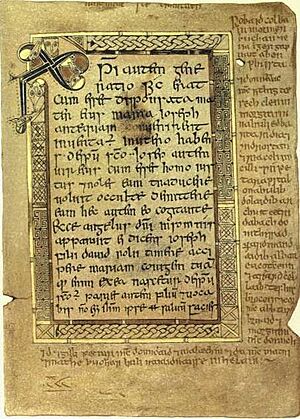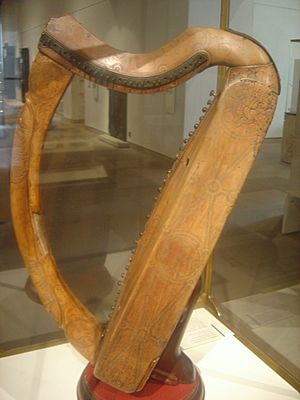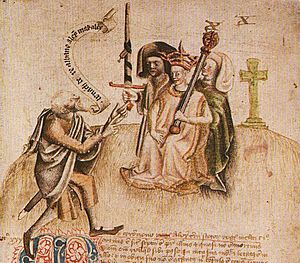Culture of Scotland in the High Middle Ages facts for kids
The culture of Scotland during the High Middle Ages (roughly 900 AD to 1286 AD) was a mix of old traditions and new influences. This period began after the death of King Domnall II and ended with the death of King Alexander III. It was a time when Gaelic culture was very strong. Later, French culture also became important, especially among the kings and nobles.
Contents
Stories and Traditions
Scotland was mostly a Gaelic-speaking country back then. Many of its cultural practices were similar to those in Ireland. After King David I, French-speaking kings brought new customs from England and France.
Storytelling was a big part of life, just like in all old societies. People loved to hear tales about heroes, myths, and history. Sadly, most of these old stories are now lost. Only a few hints remain in Gaelic or Scots oral traditions.
Family Histories (Genealogies)
One type of cultural record that survived well from this time is genealogy, which means family histories. There are many Scottish genealogies from this era. They cover everyone from local lords (called Mormaers) to the Scottish kings themselves.
For example, a very old book called the Poppleton Manuscript has a full family tree for King William I. It traces his family all the way back to Adam! Kings of Scotland also had a special royal poet, called an ollamh rígh. This poet's job was to recite the king's family tree at important events, like coronations. This showed how important the king's family line was.
Reading and Writing

Before King David I, Scotland had many skilled writers. They wrote texts in both Gaelic and Latin. These writings were often shared with Ireland and other places.
However, after David I, many English and French church leaders came to Scotland. They brought new ways of writing and thinking. Even though some Gaelic writers continued their work, especially in eastern Scotland, their written output wasn't as rich as in Ireland. Latin became the main language for official documents. Scribes often translated Gaelic words into Latin. This is why historians sometimes find it hard to understand the Gaelic society from Latin records. Even names were changed; for example, Gille Brigte became Gilbert.
Literature and Poetry
We might have more medieval Scottish Gaelic literature than we realize. Most of it survived because it was kept safe in Ireland, not in Scotland. Later Scottish kings and nobles became more influenced by French and English culture. This meant Gaelic manuscripts were not often preserved in Scotland.
For example, a text called the Lebor Bretnach (the "Irish Nennius") was probably written in Scotland. But it only exists today because copies were kept in Ireland. In fact, almost all Scottish literature from before the 1300s survived thanks to copies found in Ireland, England, or mainland Europe.
Scottish Poets
Some medieval Scottish poetry still exists. Kings likely supported Gaelic poets. In the 1200s, an Irish poet named Muireadhach Albanach wrote praise poems for the Lords of Lennox. He started a famous Scottish family of poets called the MacMhuirichs.
Another important Scottish poet was Gille Brighde Albanach. Around 1218, he wrote a poem about his experiences on the Fifth Crusade. This shows that Scottish poets were part of wider European events.
French and Latin Writings
In the 1200s, French also became a popular language for literature in Scotland. One famous example is the Roman de Fergus, which is the oldest non-Celtic story from Scotland. Some scholars believe other stories about King Arthur, written in French, might also have come from Scotland.
Latin was also used for literature. The Inchcolm Antiphoner is a famous Latin book of church songs. There's also a Latin poem called Carmen de morte Sumerledi ("Song on the Death of Somerled"). This poem celebrates a victory by the people of Glasgow over a powerful leader named Somerled. Most historical writings from this period were also in Latin.
Other Languages
There isn't much literature written in English from this time in Scotland. English literature became more common later. Some Norse literature exists from areas like the Northern Isles and Western Isles, where Vikings settled. The famous Orkneyinga Saga, which tells stories about the Earldom of Orkney, was actually written in Iceland.
Music in Medieval Scotland

Scotland was known for its musical talent in the Middle Ages. A writer named Gerald of Wales said that the Scots were very skilled at playing the harp. He even said they were better than the Irish!
The Scots took harping very seriously. King Alexander III, who died in 1286, even had his own royal harpist. Out of the three medieval harps that still exist today, two were found in Scotland.
Singers also played a special role for the king. When the King of Scotland traveled through a certain area called Strathearn, seven women would greet him with songs. This was a long-standing tradition. In 1296, when King Edward I of England came to this area, he was met by these same seven women singing to him, just as they had done for the Scottish kings before him.


